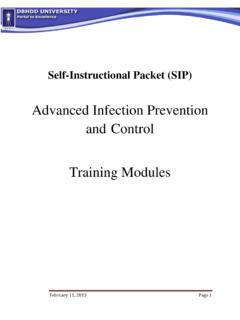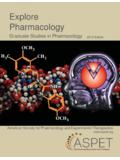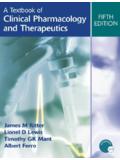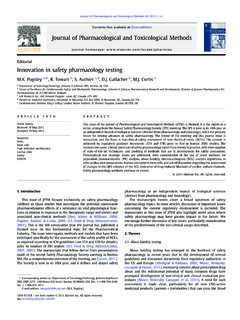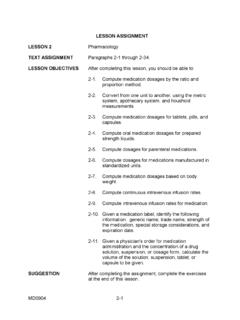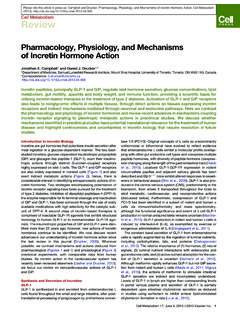Transcription of Pharmacology Self-Study Manual for Nurses
1 Pharmacology Self-Study Manual for Nurses 2012 Prepared by: Jerry Harris, MSN, RN, CNS Approved by: Statewide Nursing Leadership Committee & Division Medical Executive Committee 2 The Whys and Wherefores Before the introduction of Thorazine (chlorpromazine) in the 1950s, State Hospitals admitted thousands of incurable psychotic patients, who, more often than not, were warehoused till their dying days.
2 These institutions were so large; they resembled small towns, often growing their own food on patient-worked farms and dairies. They had their own carpentry shops, laundries, even their own surgeries. They also had, perhaps sadly, their own cemeteries. But with the advent of Thorazine, no less a miracle drug than penicillin, the incurable found reprieve from the devastating psychotic symptoms that had held them so long in their madness. And while Thorazine (and all the other antipsychotics) does not actually cure psychosis, they do give the individual a fighting chance. The hospitals began to see their populations decrease dramatically, as those once captive were able to return to the community. They were able, at long last, to go home. From Thorazine, came many other so-called anti-psychotropic medicines, mostly to our benefit.
3 But, like all medications, there are potential side effects. Some side effects are mild while others are severe, even life threatening. A few of the more common side effects associated with antipsychotic medications includes: weight gain, hyperglycemia, sedation, involuntary muscle movements, sexual dysfunction, hypotension, dry mouth and constipation. The purpose of this Pharmacology Self-Study Manual for Nurses is to provide the licensed nurse with what should be a review of common medicines used in State Hospital settings, their many and varied uses and their sometimes serious side effects. The Manual is certainly not exhaustive, but should provide the nurse with a select overview of the hospital s formulary. The objectives of this Pharmacology Self-Study Manual are, not only to help the nurse pass the requisite medication exam with an 85% or better, but, upon completion, the nurse should be able to 1) Identify medications frequently used in the mental health setting, 2) Identify side effects of various medications, 3) Identify potentially hazardous medication combinations, and 4) Identify normal lab values related to medications.
4 But before we 3 A Brief Review of the Symptoms of Schizophrenia The symptomatology of schizophrenia is divided into three broad categories. Positive Negative Hallucinations Social withdrawal (typically auditory) Emotional withdrawal Delusions ( paranoia) Lack of motivation Thought Disorder Poverty of speech ( -Disordered thinking/speech) Blunted affect Disorganized behavior Poor insight ( agitation) Poor self -care Cognitive Difficulty paying attention Memory problems Problems processing (understanding information) Notice, please, that the negative symptoms take something away from the sufferer.
5 The negative symptoms isolate the schizophrenic individual. The negative symptoms rob that person of his or her life. Also, while not generally considered a core symptom of schizophrenia, individuals with schizophrenia also have affective symptoms: depression, irritability or mood swings. The Antipsychotics Today, antipsychotic medications are generally divided into two broad categories. The first-generation antipsychotics (of which Thorazine is the patriarch) are commonly known as the conventional antipsychotics. The second-generation antipsychotics are known as atypicals. Although challenged by some studies, it is commonly thought that while the conventional antipsychotics are exceptional at ameliorating the positive symptoms of psychosis, they don t have much impact on the negative symptoms of schizophrenia, those symptoms that prevent or greatly complicate that universal need human-to-human interaction.
6 The atypicals claim to alleviate both the positive and negative symptoms. Some of the atypicals have also been approved for use in bipolar mania and some depressive disorders. 4 Commonly Used CONVENTIONAL ANTIPSYCHOTICS o Haldol (haloperidol): available in pill and liquid formulations, short acting IM formulation, and a long-lasting (4 weeks) Haldol Decanoate injection for deep IM/large muscle ( , Dorsogluteal). o Prolixin (fluphenazine): available in pill and liquid formulations, short acting IM formulation, and a long-lasting (3 weeks) Prolixin Decanoate injection(which can be administered both IM and subcutaneously) o Trilafon (perphenazine): available in pill formulation o Thorazine: available in pill, liquid and short acting IM formulations Potential Adverse Effects: * The following is an alert for all antipsychotics: [ALERT!]
7 Black Box Warning increased mortality in elderly individuals with dementia-related psychosis.] o Extrapyramidal Symptoms (EPS) include symptoms such as akathisia, dystonia, and pseudoparkinsonism. These adverse effects can be successfully treated with Benadryl, Cogentin, or Artane (see below Anticholinergics & Diphenhydramine ). Many prescribers use one of these medicines routinely to prevent the occurrence of EPS. If the psychiatric nurse must medicate an individual presenting with acute dystonia, this is considered an Adverse Drug Reaction (ADR), and hospital protocol must be observed. Lowering the dosage or stopping the offending medicine altogether may be indicated. Sometimes a beta blocker like Inderal (propranolol) or a benzodiazepine is used. o Tardive dyskinesia is a long-term side effect of anti-psychotic medications and usually consists of involuntary muscle movements of the face or extremities.
8 It is generally believed that if the condition is caught early, it can be reversed with medication withdrawal. This is why the AIMS test is important. o Neuroleptic Malignant Syndrome (NMS) is a rare reaction to antipsychotics and it can be fatal if not caught and properly treated early in its development. The primary symptoms of NMS include lead pipe rigidity, hyperpyrexia (high fever), and autonomic instability (dysrhythmias, fluctuations in blood pressure). Treatment includes immediate withdrawal of the offending agent and supportive measures to maintain homeostasis. NMS is a medical emergency and any individual exhibiting symptoms consistent with NMS must be evaluated by a physician immediately. *Mnemonic for NMS: FALTER: Fever, Autonomic instability, Leukocytosis, Tremor, Elevated enzymes like CPK, and Rigidity of muscles 5 o Orthostatic Hypotension is the significant drop in blood pressure when an individual stands from a sitting or lying position.
9 Treatment involves decreasing or changing the offending agent and/or nursing measures, such as educating and demonstrating to the individual how to slowly rise to a standing position. o Sedation, especially during initiation of the antipsychotic, is not uncommon. Fortunately, it is, more often than not, a transient phenomenon. o Agranulocytosis, while rare, is a potentially fatal untoward effect. Be alert for signs and symptoms of infection. o Dry mouth and photosensitivity are common. +++ Commonly Used ATYPICAL ANTIPSYCHOTICS o Abilify (aripiprazole)- both pill & short- acting IM formulations o Clozaril (clozapine)- pill formulation only [ALERT! Routine blood work (white blood cell count) is needed to monitor for agranulocytosis.] o Fanapt (iloperidone) pills only o Geodon (ziprasidone) both pills & short-acting IM formulations.
10 [ALERT! PO medicine must be given with food for maximum absorption.] o Invega (paliperidone)- both pills and long-acting IM (Sustenna) formulations o Latuda (lurasidone)- pills only [ALERT! medicine must be given with food for maximum absorption.] o Risperdal (risperidone)- pills, sublingual tablets, liquid and long-acting IM (Consta) formulations o Seroquel (quetiapine)- pill formulation o Saphris (asenapine) - sublingual tablets o Zyprexa (olanzapine)- pills, sublingual tablets and short-acting IM formulations. Potential Adverse Effects: In addition to the adverse effects commonly seen with conventional antipsychotics, individuals taking atypical antipsychotics are more likely to develop these additional adverse effects. o weight gain o new-onset diabetes o Dyslipidemia o Agranulocytosis 6 A Brief Review of the Symptoms of Mania Australian psychiatrist, John Cade, first linked lithium to the alleviation of manic symptoms in 1949.
